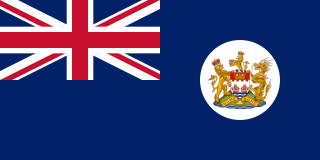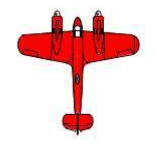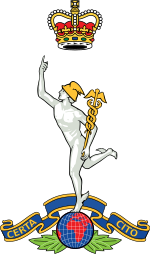
The Royal Corps of Signals is one of the combat support arms of the British Army. Signals units are among the first into action, providing the battlefield communications and information systems essential to all operations. Royal Signals units provide the full telecommunications infrastructure for the Army wherever they operate in the world. The Corps has its own engineers, logistics experts and systems operators to run radio and area networks in the field. It is responsible for installing, maintaining and operating all types of telecommunications equipment and information systems, providing command support to commanders and their headquarters, and conducting electronic warfare against enemy communications.

The Army Air Corps (AAC) is the aviation arm of the British Army, first formed in 1942 during the Second World War by grouping the various airborne units of the British Army. Today, there are eight regiments of the AAC, as well as two independent flights and two independent squadrons deployed in support of British Army operations around the world. Regiments and flights are located in the United Kingdom, Kenya, and Canada. Some AAC squadrons provide the air assault elements of 16 Air Assault Brigade, through Joint Helicopter Command.

Royal Air Force Digby otherwise known as RAF Digby is a Royal Air Force station located near Scopwick and 11.6 mi (18.7 km) south east of Lincoln, in Lincolnshire, England. The station is home to the tri-service Joint Service Signals Organisation, part of the Joint Forces Intelligence Group of Joint Forces Command. Other units include the RAF Aerial Erector School, No. 54 Signals Unit and No. 591 Signals Unit.
Options for Change was a restructuring of the British Armed Forces in summer 1990 after the end of the Cold War.

British Forces Overseas Hong Kong comprised the elements of the British Army, Royal Navy and Royal Air Force stationed in British Hong Kong. The Governor of Hong Kong also assumed the position of the commander-in-chief of the forces and the Commander British Forces in Hong Kong took charge of the daily deployment of the troops. Much of the British military left prior to the handover of Hong Kong to China in 1997. The present article focuses mainly on the British garrison in Hong Kong in the post Second World War era. For more information concerning the British garrison during the Second World War and earlier, see the Battle of Hong Kong.

The 2nd Signal Brigade, was a military formation of the British Army composed of Royal Corps of Signals units. The brigade was first formed following the reorganisation of the old Territorial Army in 1967, and was disbanded in 2012 under the Army 2020 programme. However, later the 2nd Signal Group was formed continuing the lineage of the old brigade, before it was disbanded in 2018.

36 (Eastern) Signal Regiment was a Territorial Army (TA) signal unit of the British Army's Royal Corps of Signals (RCS). The regiment was formed following the formation of the TAVR in 1967, and was disbanded in 2009 following a reorganisation in the RCS. Though not disbanded, the regiment continues its lineage as a squadron, with its own former squadrons forming troops within said squadron.

The 14th Signal Regiment (Electronic Warfare) is a part of the British Army's Royal Corps of Signals. The regiment's role is to provide electronic warfare (EW) capability in support of deployed Land Commanders, in order to enable operations in the electronic battlespace. It is the only British Army regiment capable of conducting sustainable electronic warfare in support of national operations worldwide. The regiment is currently based at Cawdor Barracks, on the site of the former RAF Brawdy, near Haverfordwest, in South Wales.

The 1st Signal Brigade, formerly known as the 1st Signal Group, is a brigade of the British Army. The group was first formed in 1968 as a result of the 1966 Defence White Paper which expanded support for NATO and the British Army of the Rhine. In 1987, the group was disbanded and merged into the 2nd Signal Brigade. In 1995, the brigade was reformed and has since deployed on operations across the globe in support of NATO and HQ Allied Rapid Reaction Corps.
Army 2020 was the name given to the restructuring of the British Army in the early and mid-2010s, in light of the Strategic Defence and Security Review 2010. The plan, as its name suggested, was intended to be completed by 2020, though most of its reorganisations were completed by the middle of the decade. It was succeeded by Army 2020 Refine, a series of new changes and refinements of Army 2020's restructuring, conducted in light of the Strategic Defence and Security Review 2015.
No. 657 Squadron AAC was a squadron of the British Army's Army Air Corps (AAC), part of the Joint Special Forces Aviation Wing based at RAF Odiham. The squadron disbanded in May 2018 after the retirement of the Westland Lynx.

The page contains the current structure of the British Army. The British Army is currently being reorganised to the Future Soldier structure.
The following is a hierarchical outline for the structure of the British Army in 1989. The most authoritative source for this type of information available is Ministry of Defence, Master Order of Battle, and United Kingdom Land Forces, HQ UKLF, UKLF ORBAT Review Action Plan, HQ UKLF, 1990.

The 12th Signal Brigade, later 12th Signal Group was a military communications formation of the British Army commanding regiments of the Royal Corps of Signals. Initially formed in 1967, the brigade would provide rear defence communications for the British Army of the Rhine until its disbandment in 1992. In 2004, the group was reformed to provide territorial army and rear support to the Allied Rapid Reaction Corps in Germany. However, in 2009 the group was disbanded following reductions to the Royal Corps of Signals and Territorial Army.

21 Signal Regiment is a signal regiment of the Royal Corps of Signals within the British Army. The regiment was, until the initial Army 2020 reforms, the only signal regiment to support the Royal Air Force.
The 4th Signal Group was a group sized unit of the Royal Corps of Signals within the British Army that supported the British Army of the Rhine. The group's main job was to supervise all of the static communications used by the British Forces in Germany. It supported the British Army of the Rhine and 2nd Allied Tactical Air Force for just under 30 years.
13 Signal Regiment is a signal regiment of the Royal Corps of Signals within the British Army.

The 15th Signal Regiment is military communications unit of the British Army's Royal Corps of Signals.

Central Volunteer Headquarters, Royal Corps of Signals is a special administrative group of the Royal Corps of Signals formed to oversee the national reserve units of the corps.

608 Signal Troop was a special communications unit of the British Army's Royal Corps of Signals and served as part of the British Army of the Rhine before being disbanded after 2001.










